The Department of Commerce recently released a second set of statistics for adjudications under the Building & Construction Industry Security of Payment Act 1999 (the Act) covering the first half of 2006 (1 January 2006 to 30 June 2006). The first set of statistics for the Act covered a 22 month period from 3 March 2003 – 31 December 2005.
Viewed as a whole, the statistics give some measure of the economic significance of the Act to the construction industry. They reveal the total amount claimed in adjudication applications over both periods is approximately $1.8 billion, and that of this $1.8 billion, Adjudicators awarded claimants approximately $1.5 billion.
Below is a graphical comparison of the statistics for the two periods and observations of general trends in adjudication outcomes and any notable shifts from these trends in the first half of 2006:
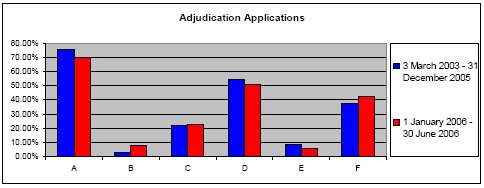
A determined
B pending determination
C completed but not determined
D adjudication where an initial Payment Schedule provided - s17(1)(a)(i)
E optional with payment schedule - s17(1)(a)(ii) & s17(2)
F optional without payment schedule - s17(1)(b)
Observations
'Second round' adjudications comprise 50% of all adjudications. The percentage of adjudication applications made under s17(1)(b), where the respondent has not provided a payment schedule (approximately two in every five), is surprising given the publicity given to the risks of failing to provide a payment schedule.
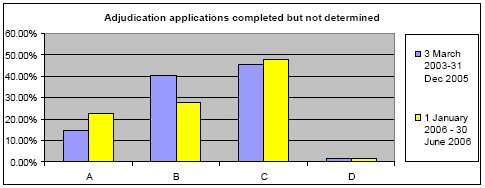
A withdrawn by claimant
B parties settled and application withdrawn
C invalid adjudication application under the Act
D ANA/Adjudicator exceeded timeframe
Observations
This is a breakdown of column C ('adjudication applications completed but not determined') in the previous table. Adjudication applications that are completed but not determined comprise approximately 21% of all adjudication applications over both reporting periods.
In the six months to 30 June 2006, the percentage of applications withdrawn by a claimant has increased significantly and settlements have decreased by more than 25%. Approximately one in ten of all adjudication applications were found by adjudicators to be invalid under the Act and no determination recorded.
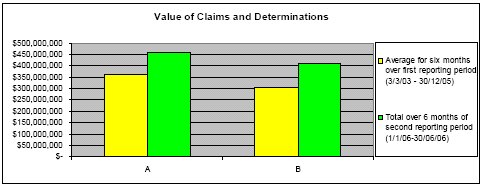
A total claims
B total awarded in determination
Observations
Just over $450 million was claimed and just over $400 million awarded in determinations over first half of 2006. Overall, approximately 78% of what was claimed was awarded. It is little wonder adjudication is so popular with claimants.
While the number of applications fell in the second reporting period, compared with the six month average for the first reporting period (from nearly 600 to 509), the graph indicates that there has been a substantial increase (approximately 25%) in the value of claims and determinations in the second reporting period. The 25% figure may be distorted slightly being a comparison of the statistics for the second period (six months in duration) and a six month average over the first period being 22 months in duration. The real increase is likely to be somewhat lower than 25% but is nevertheless substantial.
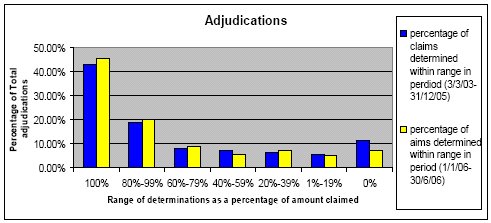
Observations
More than half of all adjudications result in an award between 80 – 100% of the amount claimed. With such consistent positive outcomes, there is little wonder security of payment adjudications are so popular with claimants for the resolution of payment claim disputes.
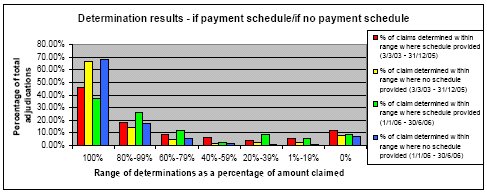
Observations
This graph compares the range of adjudicator's determinations where a payment schedule is provided and where a payment schedule is not provided over the two periods.
The benefits to a respondent in providing a payment schedule are clear. On average about 67% of all claims where no payment schedule was provided resulted in a 100% determination. In comparison, only 41% of all claims (on average) where a payment schedule was provided resulted in a 100% determination.
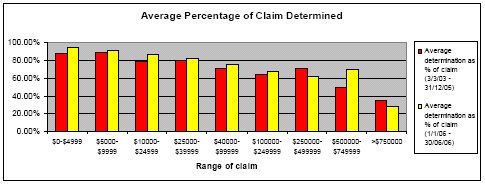
Observations
With the exception of claims in the range $500,000-$749,999 over the second period, there is a clear trend that the greater the claim the lower the percentage determined.
While there is no empirical evidence to suggest why this may be the case, it is likely that the smaller claims are 'true' progress claims while the larger claims 'burn the relationship' with speculative delay and variation claims.
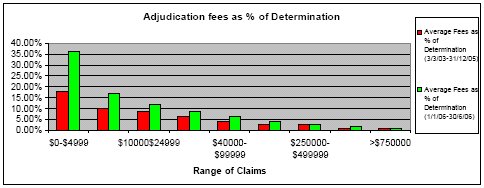
Observations
Adjudicators seem to have become bolder billers. It is clear, that over the first six months of 2006, adjudicator's fees comprised a greater proportion of the sum awarded for claims up to $250,000.00 than in the prior 22 month period. The rise in adjudication fees is particularly marked for the lower range of claims. On average 77% of fees were payable by the respondent.
While adjudicator's bills have increased, the statistics also confirm the fact that for almost every construction related payment claim dispute, adjudicator's costs are a mere fraction of the costs involved in more formal procedures such as arbitration or expert determination. Although there is no empirical evidence, the legal and expert evidence costs are also significantly reduced, as is the delay. Again, it is little wonder that adjudication is so popular with claimants.
Conclusion
Other than adjudicator's fees and an increase in the value of claims, the statistics disclose no significant difference between the two periods. The Act remains very 'claimant friendly' and continues to offer a fast and comparatively cheap method for resolving payment claim disputes.
|
Sydney |
||
|
Robert Riddell |
t (02) 9931 4940 |
The content of this article is intended to provide a general guide to the subject matter. Specialist advice should be sought about your specific circumstances.

